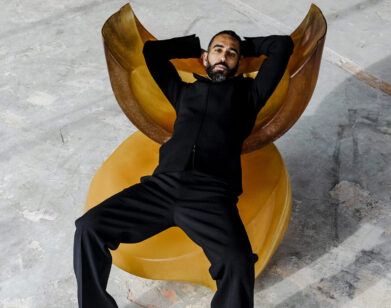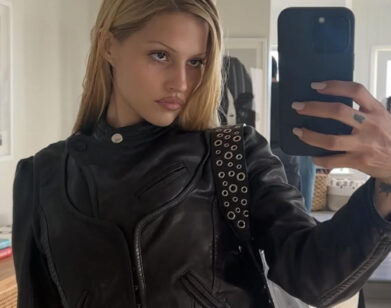All Minimalism Is Not Alike

RAF SIMONS
All minimalism is not alike, as the menswear shows in Paris over the weekend amply illustrated. While at Lanvin it was a shadow play of sport and dress, at Yves Saint Laurent, Stefano Pilati created an elegant impression of Edwardian tailoring, and Kris Van Assche stripped luxury down to fluid minimum for Dior Homme.
But first, the bad news. In a season which has seen power failures and takeover attempts, we can now add divorce. That’s the case for Raf Simons, where the announcement that he has discontinued working with the Italian Futurenet Group means the great pieces he showed this weekend probably won’t make it into stores.
Minimalism can be eye-opening when the designer has something to say. That’s the case with Simons, whose short, to-the-point collection polishes schoolboy staples like the duffle coat and college insignia sweatshirt like pieces of sculpture. Loose PVC pants paired with a camel duffle struck an exciting balance between old-school and futurism. Simons’ “Dead Prince College” sweatshirts and Nordic stripe-knit sweaters mixed with voluminous neoprene jackets and overcoats in bright purple or red. Those overcoats show the new penchant for layering, with a seam across the middle that makes them look like a jacket worn over a coat. And Simons was really far out, with propositions like mohair aprons over coats.
LANVIN; DIOR
Lanvin’s owner, Shaw-Lan Wang, posed with two vertiginous Chinese starlets before the show, a reminder for those who didn’t get the memo that Euro-American dominance in fashion has slipped. The steadily growing Lanvin is also proof that a brand can thrive on clothing independently, without fragrance and accessories leading the sales. For this collection, Lucas Ossendrijver and Alber Elbaz went minimalist, lean and sporty, but in an urban way. Those wide-brimmed hats could have been Amish or Hasidic, if they hadn’t been so rakishly technical. Bonded fabrics showed in lean jackets over flowing, pleated trousers; every white shirt with a bow tie had a black turtleneck underneath. Jackets and coats were topped with tight-fitting, minimally puffed down. The layering of same-color overcoats with scoop-neck sweaters and hooded tunic shapes looked ecclesiastical at times, but mixed with the occasional pop of color and sophisticated, silky fabrics that had nothing to do with plain and simple.
This has been a season of wide brims, and at Dior Homme, Kris Van Assche covered almost every head in his show with shady toppers. In black and occasional flashes of red, he tailored narrow lapel jackets and flowing trousers in double-faced bonded knits, which meant that sweaters, pants, jackets and coats flowed into each other. Coats turned into tunics and ponchos, and the vest, in leather, was long and almost formless.
Yves Saint Laurent’s Stefano Pilati was one of the first designers to loosen and minimalize men’s tailoring, and now he’s now gone for the straight and narrow with only a few looser volumes in the background. The slim-fitting, high-buttoning, double-breasted overcoats topped shadowy plaid slim suits with velvet trim, turtlenecks and chunky-soled shoes. This had an Edwardian, Mod look, even if Pilati traced it to Proust.
It seems only fitting to save Hermès [right] for last. Designer Veronique Nichanian has been at it for years, and she’s hit the high notes recently. Beginning began with narrow, double-breasted black and blue tailoring that anyone could wear; Nichanian added included unusual shots of turquoise for a cable knit sweater and turtlenecks. Slim cardigans and shirts are backed in knit and fronted in silk for a sleek look. And to update classic coats and knitwear, she just adds a zipper or two. There was plenty of the new thin down here, sometimes layered over jackets. And leather jumpsuits and pants displayed the house’s expertise in a perfectly modern way.






